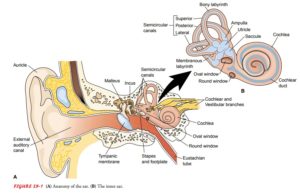How to Treat BBPV and Vertigo at Home
 Many people experience dizziness from time to time, whether that be due to standing up quickly or spinning around in circles. Despite its commonality, the term “dizziness” actually refers to multiple sensations, including pre-syncope, disequilibrium, and, you guessed it, vertigo.1 Dizziness, including vertigo, is thought to affect nearly 15-20% of adults each year, with the incidence increasing as one age.2 Vertigo, in particular, seems to be more prevalent in women compared to men.
Many people experience dizziness from time to time, whether that be due to standing up quickly or spinning around in circles. Despite its commonality, the term “dizziness” actually refers to multiple sensations, including pre-syncope, disequilibrium, and, you guessed it, vertigo.1 Dizziness, including vertigo, is thought to affect nearly 15-20% of adults each year, with the incidence increasing as one age.2 Vertigo, in particular, seems to be more prevalent in women compared to men.
What is Vertigo or BPPV?
If you have never experienced vertigo, the best way to describe the condition is that it is the illusion of movement or motion, though none exists.2 In other words, imagine that the room is spinning, swaying, or tilting, although you are standing still.2 You may hear the general term “vertigo” often referred to as benign paroxysmal positional vertigo (BPPV), since it is the most common cause of the condition, accounting for nearly one-half of all vertigo cases.2 To understand more, let’s break down the components of BPPV.

The first term, “benign,” meaning gentle or unharmful, demonstrates that although it can be a bothersome problem, vertigo is rarely life-threatening (except if it increases your chance of falls).3 The Merriam-Webster dictionary defines “paroxysmal” as “a sudden attack or spasm (as of a disease.”4 In other words, vertigo can come on suddenly and without warning. The “positional” aspect of the condition refers to the fact that symptoms of BPPV are normally triggered by changes in your head position – tilting your head, lying down, sitting/standing up, etc.3 Finally, the “vertigo” part of BPPV is an all-encompassing term that we described earlier.
“But, wait,” you might say. “Vertigo is the illusion of movement where there is none. However, the positional aspect of BPPV suggests that there is a movement component of this condition? I’m confused!” If this crossed your mind, then you must be paying attention! To explain this, we must take a look at the anatomy of the ear (yes, the ear)!
Do you have dizziness and headaches? See our review of the best ways to decrease neck stiffness at home with this helpful guide.
Anatomy of the Inner Ear
 The ear plays a critical role in our vestibular senses, including our sense of balance.5 The organ that controls this sense of balance (named the “cochlea”) is located in our inner ear and is composed of three semicircular canals and two otolith organs, all of which are filled with fluid.5 When we tilt our head up, down, left, right, or diagonally, the fluid in the semicircular canals flows in the direction of the movement and bends tiny hairs in the canal, sending a signal to the brain to alert us that we have moved.5 Within the two otolith organs are tiny crystals called otoconia (“ear rocks”) on top of the hair cells.5 They are displaced when you accelerate and thus make us sensitive to changes in gravity, such as when we ascend on an elevator or slam on the brakes in a car.5 This vestibular information is processed in the brain and combined with information from other parts (like the eyes, muscles, joints) so we can effectively maintain our balance and position.
The ear plays a critical role in our vestibular senses, including our sense of balance.5 The organ that controls this sense of balance (named the “cochlea”) is located in our inner ear and is composed of three semicircular canals and two otolith organs, all of which are filled with fluid.5 When we tilt our head up, down, left, right, or diagonally, the fluid in the semicircular canals flows in the direction of the movement and bends tiny hairs in the canal, sending a signal to the brain to alert us that we have moved.5 Within the two otolith organs are tiny crystals called otoconia (“ear rocks”) on top of the hair cells.5 They are displaced when you accelerate and thus make us sensitive to changes in gravity, such as when we ascend on an elevator or slam on the brakes in a car.5 This vestibular information is processed in the brain and combined with information from other parts (like the eyes, muscles, joints) so we can effectively maintain our balance and position.
Normally, these parts all work together well. When your head remains stationary, the hair cells neither move nor fire, and we do not experience motion. However, it is possible for the otoconia in the otoliths to dislodge and end up in the semicircular canals.3 This displacement causes you to become sensitive to head position changes that would normally not excite the hair cells in the canals, leading to the dizziness that one might describe as “vertigo.”3
Symptoms of Vertigo
Though symptoms can range in severity, the most classic feature is sudden-onset vertigo induced by changing head position.6 Symptoms typically decrease when at rest, but some patients do report consistent light-headedness between episodes.1,6 A clinical feature of BPPV is something known as “nystagmus,” or repeated oscillations of the eyes back and forth.7 Both vertigo itself and a neurological sign of nystagmus can be reproduced with provocative movements, which is helpful in diagnosing the condition. The Dix. Hallpike maneuver is the hallmark test for diagnosing BPPV since it includes maneuvering a patient through a series of movements to exacerbate the symptoms and clinical signs of BPPV.1,3
Is all Dizziness Vertigo?
One of the difficulties in accurately diagnosing BPPV is the fact that many people may use the terms “dizziness,” “lightheadedness,” and “vertigo” interchangeably. While dizziness is a general disturbance of spatial orientation, vertigo is specifically an inaccurate perception of movement.8 Thus, although vertigo is a type of dizziness, not all dizziness is necessarily vertigo. In fact, there are three other types of dizziness, including disequilibrium, presyncope, and lightheadedness.9 While we have already thoroughly detailed the feelings of vertigo, it is important to understand what we mean when describing the other types of dizziness.

“Disequilibrium” refers to a change in the balance of coordination that impairs one’s ability to walk.9 When this happens, patients will oftentimes explain that they know the problem is in their legs, but they also experience dizziness in their head as well.9 Contrastingly, feelings of “(pre)syncope” occur when a patient senses the impending loss of consciousness.9 In other words, they feel like they might (or actually do) “pass out.” Common causes of this include a sudden drop in blood pressure upon standing (orthostatic hypotension), medications, cardiac arrhythmias, hypovolemia, and/or hyperventilation.10 Lastly, “lightheadedness” is, inherently, an imprecise description to articulate a feeling of dizziness that is neither presyncope nor vertiginous.9
How to Self Diagnose Vertigo at Home
While the official diagnosis of BPPV must occur in a physician’s office, if you suspect that you have BPPV, there is an easy way to test yourself at home. This method also helps to determine which side is affected by BPPV.11
To determine the BPPV-affected side (Dix-Hallpike test):
- Sit on your bed
- Position yourself so that if you were to lie down on your back, your head would hand over the edge of the bed
- While sitting up, turn your head to the right and quickly lay back
- Lay on your back and wait for 1 minute
- If you begin experiencing vertigo/dizziness, then your symptoms are due to dysfunction of your right ear
- If no dizziness occurs, return to a seated position and wait 1 minute
- Turn your head to the left and quickly lay back
- Lay on your back and wait for 1 minute
- If you begin experiencing vertigo/dizziness, then your symptoms are due to dysfunction of your left ear
Self-treatment Methods for Vertigo
Home Epley Maneuver
After determining the ear affected by BPPV, the home Epley maneuver (also known as Canalith repositioning procedure) is a controlled set of head movements that can be used to shift the otoconia back into their original home in the otolith organs.2 However, the procedure may not be tolerated by elderly patients or those with severe symptoms. It should not be performed if you have a history of cervical spine injury.
Steps:
- Sit on your bed
- Position yourself so that if you were to lie down on your back, your head would hand over the edge of the bed
- While sitting up, turn your head toward your affect ear and quickly lay back
- Hold this position
- While laying down, slowly turn your head towards your unaffected ear
- Roll on to your side, keeping the unaffected ear down
- Turn your body so your nose is turned towards the floor
- Hold position
- Sit up, making sure to keep your chin tucked downwards.
- Hold seated position
Foster Half Somersault
The half somersault, also known as the Foster maneuver, is another method that has been shown to help reduce symptoms of vertigo. In a randomized single-blind study, the Foster maneuver was shown to be better tolerated by patients, as they experienced less dizziness during the treatment and had fewer side effects.12 The half somersault does not include the Dix-Hallpike maneuver (as the Epley maneuver does), nor does it require an assistant.12
Steps (for right-sided BPPV):
- Begin by kneeling, with shins on the ground. Use your hands to stabilize yourself
- While kneeling, quickly tip the head upward and backward
- Hold for 15 sec
- Assume somersault position by tucking your chin to your knees
- Hold 15 sec
- Maintain half somersault position and turn head ~45 degrees to face the right elbow
- Hold 15 sec
- While maintaining the head at 45 degrees, raise your head to back level
- You should be on all fours with your back parallel to the ground
- Hold 15 sec
- While maintaining the head at 45 degrees, raise the head to a fully upright position
- Hold 15 sec
Brandt Daroff Exercises
Although some studies report the Brandt-Daroff exercises to be less effective in relieving vertigo symptoms, others have shown similar efficacy in these exercises when compared to maneuvers like the Epley or Semont maneuver.13 The focus on the Brandt-Daroff exercises is to expedite the compensation process and relieve the symptoms of vertigo.14 These exercises may be safer for people with spine or back injuries, compared to the other maneuvers.
Steps (for right-sided BPPV):13
- Begin in an upright, seated position on the edge of a bed/couch
- Move into a lying position on your left side and while doing so, turn head 45 degrees towards the left shoulder
- Hold lying down position with head looking up 45 degrees for 30 sec
- Return to the seated position
- Hold 30 sec
- Repeat on the other side
Most physicians recommend patients perform multiple repetitions of these exercises at least twice per day.
Conclusion
Not only is vertigo frustrating to describe, but also frustrating to experience, especially when the symptoms seem to appear and disappear at random. While there are certain medications and treatments that can acutely resolve the symptom of vertigo, it is important to understand what might be the root cause of the problem and attempt to remediate it. Fortunately, the cure for many living with this condition may simply involve the above exercises that can be done at home, given physician permission and guidance. It is our hope that the above exercises and knowledge may serve as an effective starting point to help you manage and potentially even cure your vertigo!
Works Cited
- Thompson, T.L., and Amedee, R. (2009). Vertigo: A review of common peripheral and central vestibular disorders. Ochsner Journal 9, 20–26.
- Palmeri, R., and Kumar, A. (2020). Benign Paroxysmal Positional Vertigo (BPPV) (StatPearls Publishing).
- Benign paroxysmal positional vertigo (BPPV) – Symptoms and causes – Mayo Clinic. Retrieved from https://www.mayoclinic.org/diseases-conditions/vertigo/symptoms-causes/syc-20370055
- Paroxysm | Definition of Paroxysm by Merriam-Webster. Retrieved from https://www.merriam-webster.com/dictionary/paroxysm.
- How does our sense of balance work? – InformedHealth.org – NCBI Bookshelf. Retrieved from https://www.ncbi.nlm.nih.gov/books/NBK279394/.
- Hornibrook, J. (2011). Benign Paroxysmal Positional Vertigo (BPPV): History, Pathophysiology, Office Treatment and Future Directions. International Journal of Otolaryngology.
- Parnes, L.S., Agrawal, S.K., and Atlas, J. (2003). Diagnosis and management of benign paroxysmal positional vertigo (BPPV). CMAJ 169, 681–693.
- Michael Strupp, and Thomas Brandt (2008). Diagnosis and Treatment of Vertigo and Dizziness. Deutsches Arzteblatt International 105.
- Reilly, B.M. (1990). Dizziness.
- Seger, J.J. (2005). Syncope evaluation and management. In Texas Heart Institute Journal, (Taylor & Francis), pp. 204–206.
- Benign Paroxysmal Positional Vertigo (BPPV) Diagnosis and Tests | Cleveland Clinic. Retrieved from https://my.clevelandclinic.org/health/diseases/11858-benign-paroxysmal-positional-vertigo-bppv/diagnosis-and-tests.
- Foster, C.A., Ponnapan, A., Zaccaro, K., and Strong, D. (2012). A Comparison of Two Home Exercises for Benign Positional Vertigo: Half Somersault versus Epley Maneuver. Audiology and Neurotology Extra 2, 16–23.
- Fife, T.D., Iverson, D.J., Lempert, T., Furman, J.M., Baloh, R.W., Tusa, R.J., Hain, T.C., Herdman, S., Morrow, M.J., and Gronseth, G.S. (2008). Practice Parameter: Therapies for benign paroxysmal positional vertigo (an evidence-based review).
- Brandt-Daroff Exercise for Vertigo | Michigan Medicine.Retrieved from https://www.uofmhealth.org/health-library/hw205649.
Disclaimer: The information provided in this post is for educational purposes only. This is not a substitute for a medical appointment. Please refer to your physician before starting any exercise program.
